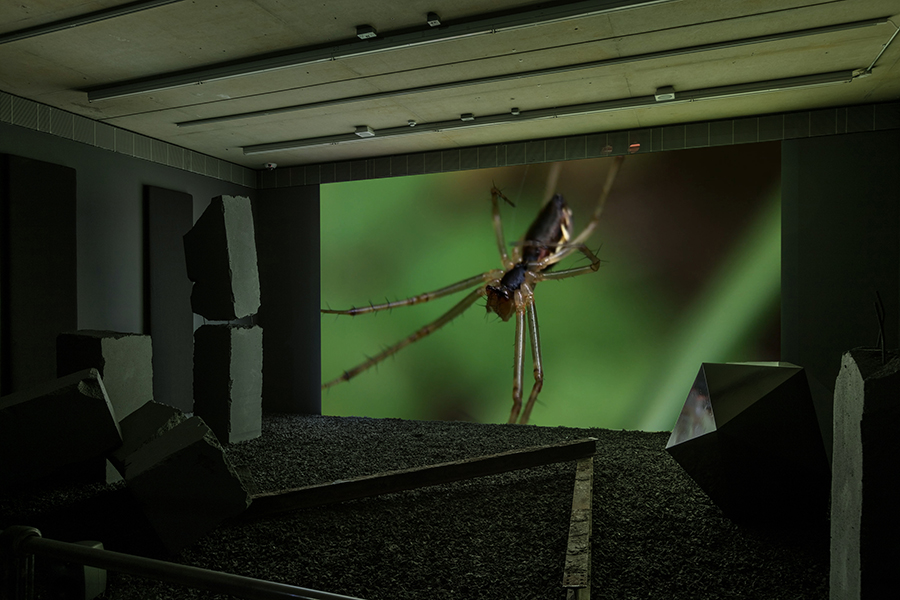David Blandy and a Cadre of Essex Gamers Introduce us to a World After Homo Sapiens
In an exhibition at Focal Point Gallery, the artist looks to the local marshes of Canvey Island with a weird degree of hope
In an exhibition at Focal Point Gallery, the artist looks to the local marshes of Canvey Island with a weird degree of hope

In 1970, in the marshes of Canvey Island, Essex, a petroleum refinery was planned and built, before being abandoned five years later following the OPEC oil crisis of 1973–74. Since then, the site has been slowly reclaimed by nature, becoming one of the most biodiverse areas of the UK, apparently equal to a rainforest in terms of species per square metre.
These hushed wetlands are the focus of David Blandy’s exhibition ‘The World After’, consisting of a new film installation and tabletop roleplaying game (RPG) of the same name. Blandy looks at the locale’s fecund present and towards its distant, posthuman future, imagining the Canvey of the 101st century as a site of ecological and societal renewal, after a manmade – and all-too-plausible – environmental ‘cataclysm’, has laid waste to our fragile Earth.

Shot on an iPhone (that most emblematic of Anthropocene artefacts), Blandy’s film takes its cue from nature documentaries – or more precisely from the scenes in Terrence Malick movies that pause the onscreen drama by cutting to footage of fauna and flora – as if to suggest the indifference of the rest of the planet’s lifeforms to passing human concerns. Soundtracked by the Southend Symphony Orchestra’s melancholy, swooning score, the industrial ruins of the refinery site pass through the four seasons. In tight, exquisitely filmed close-ups, raindrops hang fatly from spring shoots, and winter frost dusts vegetation, so that it resembles the gemstone-crusted jungle of J.G. Ballard’s novel The Crystal World (1966). Nature arcs through its timeless cycle of reproduction and death: bees gather pollen, ants feast on the corpse of a dead earth worm, and spiders (creatures long associated with storytelling in folklore) weave their sticky webs.
Two voiceovers, one old and male, the other young and female, relate how homo sapiens paved the road for its own destruction: ‘Oil was once so plentiful they built a whole culture around it, burning it to power their lives.’ Our narrators, it seems, are our species’ descendants; the landscape, not a present-day Canvey, but ‘The World After, Fain’. Looking around the screening room, we are confronted both by 21st-century detritus (seating made from materials salvaged from Southend pier, pellets recycled from tires covering the floor like oil on a beach), and a large black, polygonal mass that recalls the monolith in 2001: A Space Odyssey (1968), an object that functioned in Stanley Kubrick’s film as a kind of evolutionary accelerator. It is, in fact, a scaled-up ‘d20’, or 20-sided dice, and alludes to the participatory-artwork-as-RPG that forms the twin component of the exhibition.

Developed in collaboration with a cadre of Essex gamers, Blandy’s RPG follows a format popularly established by the Dungeons and Dragons franchise (1974–ongoing). The game takes the form of an illustrated book detailing a fantasy world, and a set of rules for navigating it through collective, speech-based roleplay, in which the ‘d20’ functions, in effect, as the hand of capricious fate.
Blandy’s game, however, is no derivative, sub-J.R.R. Tolkien quest narrative. Massively extending the vision of a future Canvey hinted at in his film, it introduces us to several playable factions of post-humanity, including the biologically intersex Safeer, the amphibious, techno-mystical Nautia, and the matriarchal society of the Dahra. As a work of science fiction, it feels at once fresh, deeply imagined and unusually politically engaged. Unlike much participatory art, it provides a framework for genuine and sustained communal creativity. At a time when homo sapiens faces an existential crisis, roleplaying as our own evolutionary successors feels both a sobering prospect, and an odd source of hope.
Main image: David Blandy, ‘The World After’, 2019, cutout, installation view. Courtesy: the artist and Focal Point Gallery, Southend-on-Sea, UK






















